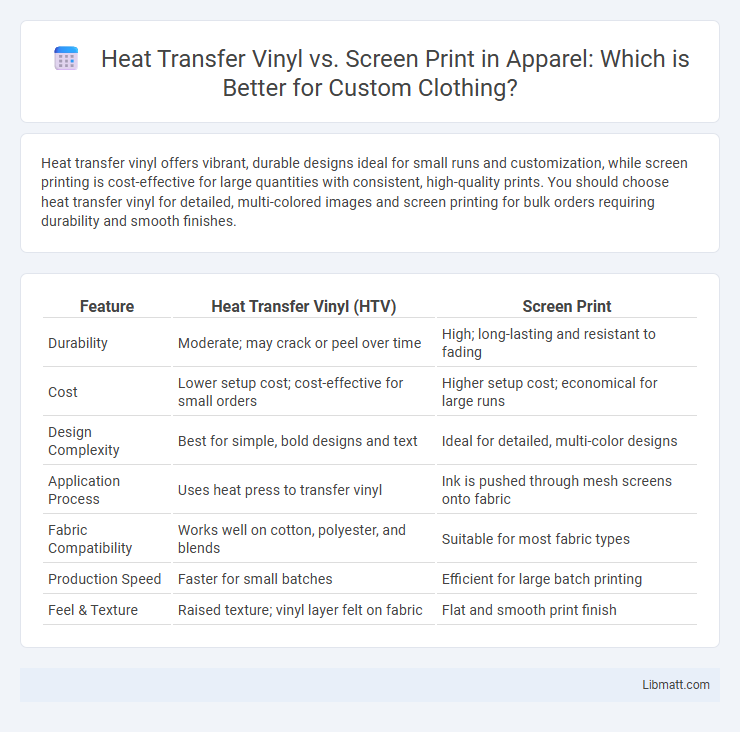Heat transfer vinyl offers vibrant, durable designs ideal for small runs and customization, while screen printing is cost-effective for large quantities with consistent, high-quality prints. You should choose heat transfer vinyl for detailed, multi-colored images and screen printing for bulk orders requiring durability and smooth finishes.
Table of Comparison
| Feature | Heat Transfer Vinyl (HTV) | Screen Print |
|---|---|---|
| Durability | Moderate; may crack or peel over time | High; long-lasting and resistant to fading |
| Cost | Lower setup cost; cost-effective for small orders | Higher setup cost; economical for large runs |
| Design Complexity | Best for simple, bold designs and text | Ideal for detailed, multi-color designs |
| Application Process | Uses heat press to transfer vinyl | Ink is pushed through mesh screens onto fabric |
| Fabric Compatibility | Works well on cotton, polyester, and blends | Suitable for most fabric types |
| Production Speed | Faster for small batches | Efficient for large batch printing |
| Feel & Texture | Raised texture; vinyl layer felt on fabric | Flat and smooth print finish |
Introduction to Heat Transfer Vinyl vs. Screen Print
Heat Transfer Vinyl (HTV) and Screen Printing are two popular methods for customizing apparel, each offering distinct benefits in durability and design flexibility. HTV uses a vinyl material that is cut and heat-pressed onto fabric, ideal for small runs and intricate designs with vibrant colors. Screen Printing involves pushing ink through a mesh stencil onto fabric, preferred for large orders due to its cost-effectiveness and long-lasting print quality.
Overview of Heat Transfer Vinyl (HTV)
Heat Transfer Vinyl (HTV) is a durable, flexible material used to create custom designs on fabrics through heat application, offering vibrant colors and sharp detail. Unlike screen printing, HTV allows for precise customization with complex patterns and multiple colors without the need for separate screens. Its versatility makes HTV ideal for small batch production, personalized apparel, and designs requiring intricate details or gradients.
Understanding Screen Printing
Screen printing uses a mesh stencil to transfer ink onto fabric, creating vibrant and durable designs suitable for bulk orders and long-lasting wear. Heat transfer vinyl involves cutting designs from colored vinyl sheets, which are then heat-pressed onto garments, offering flexibility for small runs and custom work. Your choice depends on the complexity, quantity, and durability requirements of the print job.
Durability: HTV vs. Screen Print
Heat transfer vinyl (HTV) offers superior durability in terms of maintaining vibrant colors and resisting cracks or peeling over multiple washes compared to traditional screen printing. Screen print durability depends heavily on ink type and curing processes but often fades or cracks sooner with frequent laundering. HTV's thermoplastic composition provides enhanced longevity, making it ideal for apparel that requires repeated washing without significant degradation.
Design Flexibility and Detail Comparison
Heat transfer vinyl offers superior design flexibility by enabling intricate, multi-color patterns with precise cuts and easy layering, making it ideal for detailed graphics and custom text. Screen printing excels in durability and vibrancy for large, bold designs but struggles with fine details and multiple colors without increasing production complexity and cost. Choosing between the two depends on project needs: heat transfer vinyl suits complex, small-batch designs, while screen printing is more cost-effective for high-volume, straightforward prints.
Production Process and Turnaround Time
Heat transfer vinyl involves cutting designs from vinyl sheets and heat-pressing them onto garments, enabling quick changes without setup time for each design. Screen printing requires creating screens for each color and can take longer due to drying and curing processes, often resulting in higher initial setup times but faster production for large runs. Your choice depends on whether you need rapid turnaround for small batches or efficient mass production.
Cost Analysis: HTV vs. Screen Print
Heat transfer vinyl (HTV) typically involves lower upfront costs due to minimal equipment requirements, making it ideal for small runs and custom designs, while screen printing requires significant initial investment in screens and presses but becomes more cost-effective with larger production volumes. HTV offers flexibility in design changes without additional setup expenses, whereas screen printing's cost per unit decreases substantially as order quantities increase, balancing efficiency and scalability. For businesses prioritizing volume and long-term cost savings, screen printing presents better cost efficiency; HTV suits low-quantity, varied designs due to its affordability in small batches.
Best Applications for Each Method
Heat transfer vinyl excels in creating vibrant, detailed designs on small batches or custom garments, making it ideal for personalized apparel and promotional items. Screen print is best suited for large-volume orders due to its durability and cost-effectiveness, producing high-quality, long-lasting prints on cotton and polyester fabrics. Your choice depends on the project scale and fabric type, with heat transfer vinyl favored for versatility and screen print for bulk efficiency.
Care, Maintenance, and Longevity
Heat transfer vinyl offers superior durability and maintains vibrant colors through repeated washing, requiring gentle care such as cold water washing and air drying to prolong its lifespan. Screen printing, while cost-effective for large orders, may fade or crack over time, especially with harsh detergents or high heat drying. To ensure your designs last, opt for heat transfer vinyl when prioritizing longevity and ease of maintenance.
Choosing the Right Method for Your Project
Heat transfer vinyl offers vibrant colors and precise designs, making it ideal for small runs and custom apparel with intricate details. Screen printing excels in cost-effectiveness and durability for large orders, producing consistent, high-quality prints on various fabrics. Your choice depends on project size, budget, and desired finish, with heat transfer vinyl suited for customization and screen printing for bulk production.
heat transfer vinyl vs screen print Infographic

 libmatt.com
libmatt.com